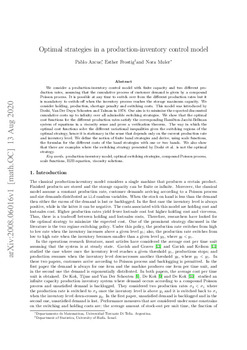Mostrar el registro sencillo del ítem
Optimal strategies in a production-inventory control model
| dc.rights.license | https://creativecommons.org/licenses/by-sa/2.5/ar/ | es_AR |
| dc.contributor.author | Azcue, Pablo | es_AR |
| dc.contributor.author | Muler, Nora | es_AR |
| dc.contributor.author | Frostig, Esther | es_AR |
| dc.date.accessioned | 2023-05-31T17:57:01Z | |
| dc.date.available | 2023-05-31T17:57:01Z | |
| dc.date.issued | 2020 | |
| dc.identifier.uri | https://repositorio.utdt.edu/handle/20.500.13098/11848 | |
| dc.identifier.uri | https://doi.org/10.1007/s11009-023-10024-3 | |
| dc.description.abstract | We consider a production-inventory control model with finite capacity and two different production rates, assuming that the cumulative process of customer demand is given by a compound Poisson process. It is possible at any time to switch over from the different production rates but it is mandatory to switch-off when the inventory process reaches the storage maximum capacity. We consider holding, production, shortage penalty and switching costs. This model was introduced by Doshi, Van Der Duyn Schouten and Talman in 1978. In their paper they found a formula for the long-run average expected cost per unit time as a function of two critical levels, in this paper we consider expected discounted cumulative costs instead. We seek to minimize this discounted cost over all admissible switching strategies. We show that the optimal cost functions for the different production rates satisfy the corresponding Hamilton-Jacobi-Bellman system of equations in a viscosity sense and prove a verification theorem. The way in which the optimal cost functions solve the different variational inequalities gives the switching regions of the optimal strategy, hence it is stationary in the sense that depends only on the current production rate and inventory level. We define the notion of finite band strategies and derive, using scale functions, the formulas for the different costs of the band strategies with one or two bands. We also show that there are examples where the switching strategy with two critical levels is not optimal. | es_AR |
| dc.description.sponsorship | Este documento es una versión del artículo publicado en Methodology and Computing in Applied Probability, 25(1) | es_AR |
| dc.description.uri | https://doi.org/10.1007/s11009-023-10024-3 | |
| dc.format.extent | 31 p. | es_AR |
| dc.format.medium | application/pdf | es_AR |
| dc.language | eng | es_AR |
| dc.relation.isversionof | Methodology and Computing in Applied Probability volume 25, Article number: 43 (2023) https://doi.org/10.1007/s11009-023-10024-3 | |
| dc.rights | info:eu-repo/semantics/openAccess | es_AR |
| dc.subject | Production-inventory control model | es_AR |
| dc.subject | Cumulative process of customer demand | es_AR |
| dc.subject | Storage maximum capacity | es_AR |
| dc.subject | Expected discounted cumulative costs | es_AR |
| dc.subject | Variational inequalities | es_AR |
| dc.subject | Costs of the band strategies | es_AR |
| dc.title | Optimal strategies in a production-inventory control model | es_AR |
| dc.type | info:eu-repo/semantics/preprint | es_AR |
| dc.type.version | info:eu-repo/semantics/submittedVersion | es_AR |
Ficheros en el ítem
Este ítem aparece en la(s) siguiente(s) colección(ones)
-
Artículos presentados, aceptados y publicados
Publicaciones de investigadores ditellianos en revistas científicas

